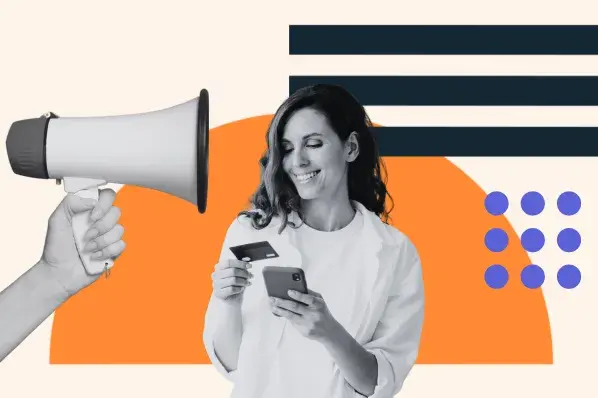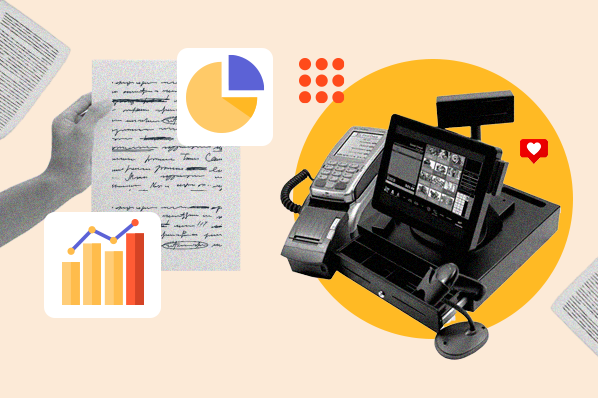But I’ve quickly realized that referral customers aren’t just exciting to have, they’re actually more cost effective to acquire and offer long-term revenue gains for my company. Referral customers spend more money on average than traditionally acquired customers and they tend to refer other customers more often. Referral customers are basically the ideal customers to acquire!
You might be wondering how to go about asking your current customers to open up their network to you for referrals. In this article, I’ll walk through how to identify potential referral opportunities and show you how to ask for a referral once you’ve identified your customer advocates.
Table of Contents
- Referral Email
- Methods to Ask for Referrals
- How to Write a Referral Email
- How to Identify Referral Opportunities
- Customer Referral Letter Templates
- Referral Email Examples
A referral email should include a few standard things. It should include an enticing email subject line, both addresses, and a signature at the end. The body of the email should include a mention of your great work with the recipient, an incentive or offer, and a call-to-action.
Referral emails aren’t meant to be long, so you don’t need to elaborately detail all of the positive interactions you’ve had with the recipient in the past. If they have a good relationship with your business, they won’t need to be persuaded with a recount of all of your history.
How to Write a Referral Email
Before you draft your referral email, there are a few important things to consider. I’ve included some tips below to help you craft the most effective message to your customers.
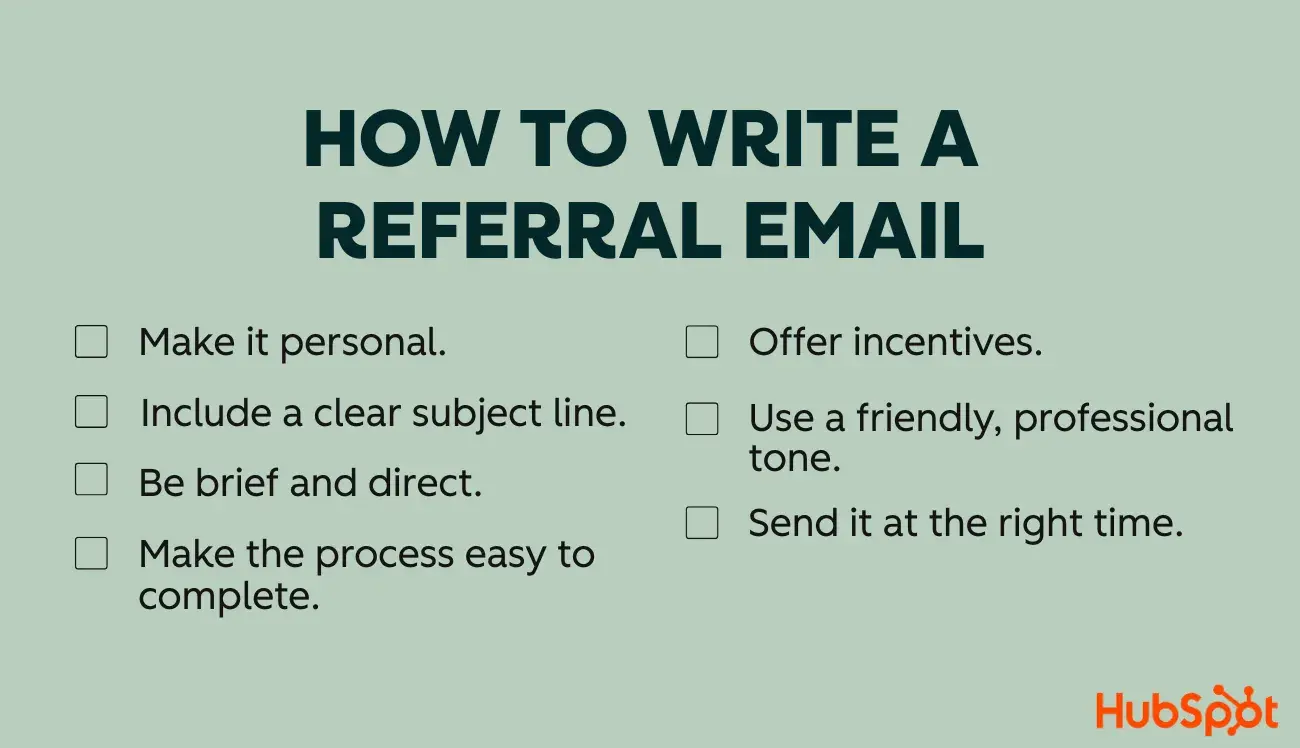
1. Make it personal.
While you might be tempted to create an email blast and BCC a group of your customers, I promise that taking the time to personalize your referral request emails is worth it.
Include the recipient’s name as well as any specific interactions they’ve had with you or your brand. If there’s a mutual acquaintance you’re hoping to get connected with, mention this as well.
If your brand solves a particular problem, hone in on this with your request and mention that you’re looking to help other customers in their network that are facing a similar challenge.
Pro tip: When I ask my customers for a referral, I like to highlight their successes and how they overcame a specific challenge to get to where they are now. This makes them feel proud of the work they’ve done and it also makes them feel good about referring someone else in their industry who is likely facing a similar challenge.
For example, I might say something like, “I know you brought [our product] in to help auto-qualify more leads due to reduced [SDR ] headcount, and I was really excited for you all when you blew past your lead gen goal this quarter!”
2. Include a clear subject line.
You shouldn’t be afraid of asking your happy customers for a referral. By including a clear ask in your subject line, you project confidence (and transparency) about your ask.
If you’re offering an incentive (more on that later), you can consider including that in your subject line. Or you can include a pain point or value add about your product in the subject line, which helps frame your ask around the problem your product can solve. Whatever you do, try not to make it sound too salesly.
Here are a few example subject lines you can experiment with.
- Example 1: Straightforward. “Know anyone who might benefit from [your company]?”
- Example 2: Lead with an incentive. “$25 Amazon gift card for a quick referral?”
- Example 3: Highlight the customer’s experience. “Your experience with [your company] could help someone in your network.”
- Example 4: Painpoint/value add focused. “Referral request: Help other CMOs drive more lead generation.”
Pro tip: Know your audience and tailor your subject line and email copy accordingly. In my experience, most C-suite members don’t care much about receiving a $25 gift card for a referral, so if you lead with that subject line they’re likely to ignore or delete your email.
See #5 below for more ideas on how to incentivize different personas to give referrals.
3. Be brief and direct.
As we all know, people have short attention spans these days. This means that if your email reads like a novel, your customers won’t read it.
Keep your email brief, be direct with your ask, and include what the customer can expect if they choose to participate. For example, will you expect a warm handoff from them, or for them to join a phone call with the referee?
Your ask should include information on why you’re asking for a referral. If they’ve achieved a specific outcome with your offering or have expressed that they’re a happy customer, include that in your brief email body. Or, if you’re reaching out because they’re in the same role or industry as someone you’re looking to connect with, you can reference that.
Pro tip: I recommend keeping your email to one to two short paragraphs, or 10 sentences maximum. Make your CTA really clear so that if they’re interested, they can easily participate.
4. Make the process easy to complete.
Standardizing the referral process simplifies the submission process for your customers and makes the life of your sales and marketing teams easier.
Creating a referral form for customers enables them to submit referrals on their own time, and it helps your team easily track and process the incoming referrals.
I personally prefer standardized submission processes for initiatives like this because it increases the chances that you’ll get the referral. Filling out a quick form takes less time (and brainpower) for customers versus asking them to respond via email.
Additionally, with a submission form you can ask guiding questions to get them thinking, which is likely to create a better output.
Pro tip: I’ve seen companies use chatbots as a reference intake form as well. This can be a cool experience for your customers as it feels more conversational, which can often lead to them giving you more context than they might when filling out a form.
Bonus points if the chatbot can automatically pull in the referrer’s contact info, which would reduce the amount of information the customer would need to provide in the referral process.
5. Offer incentives.
Let’s face it — free promotion is hard to come by these days. Offering incentives for a referral is a great way to get your customers excited about referring people in their network to your company.
Here’s a few ideas of incentives you could offer to your customers for referrals:
- Free company swag.
- A gift card.
- A donation to a charity of their choice.
- Reduced (or free) tickets to your annual user conference (I would save this one for closed/won deals that came from referrals).
- Exclusive access to new products or insider events.
Incentivizing the C-Suite
When it comes to executive stakeholders, you may have to work a little harder to incentivize them to participate in a referral program. Talk to your own C-suite and try to understand what would entice them to participate in a referral process.
Here’s a few ideas to get you started:
- Special company swag reserved just for executive stakeholders.
- VIP access to product launches, events, or one-on-one time with your company’s C-suite.
- Charity donation to a cause they care about.
- Return the favor — loop in their counterpart at your company and see how your company could contribute referrals back to them.
Pro tip: Many companies with customer loyalty programs will weight referrals higher, meaning they’ll award higher-value rewards or points to customers who participate in referral programs.
6. Use a friendly, professional tone.
While I personally love adding a few good exclamation marks in my emails, a referral request email warrants a friendly but professional tone. You can establish a warm greeting and sincere signoff, but opt for neutral language in the body of the email.
It can be easy for us to turn these emails towards ourselves, but it’s best practice to keep the email focused on the recipient of your email as well as the problem you’re trying to solve. Instead of saying, “I was wondering if you’d give me a referral,” say something like, “Do you have anyone in your network who might benefit from [xyz] as well?”
Be genuine about why you’re asking the individual recipient for a referral, and keep the message focused on them, their success, and how their referral could help other customers in their network.
Pro tip: An easy way to stay focused on the customer is to proofread your email after writing it, but before sending it. If you’re using a lot of “I’s” or “me’s” in the body of the email, consider rewriting it. And as mom always says, “Don’t forget to say please and thank you!”
7. Send it at the right time.
Happy customers make the best referrers. Identify when your customers start to see value with your product and take the opportunity to ask them for a referral.
If you’re in SaaS, this might look like waiting until after the implementation phase is completed and the customer is starting to see results with your offering. Post implementation, you could also dedicate specific milestones that warrant a referral request, such as at renewal or when a customer submits a positive NPS score.
You can create an automation that triggers a referral request based on user behavior, such as hitting a milestone with a product, leaving a good review, or making a second purchase. If you do decide to use automation, make sure you’re leveraging personalization so it feels authentic and not spammy. You should also carefully review the automation’s triggers to ensure that your customers aren’t constantly inundated with referral requests.
Now that you know the basics of crafting a great referral request email, let’s look at how to identify the best customers to ask for a referral.
How to Identify Referral Opportunities
Identifying which of your clients are the happiest and prioritizing them in your referral efforts is the key to winning more referrals. Here are some tips for going about it.
1. Identify your happy customers.
While identifying customer advocates can seem like a daunting task, using a structured feedback metric like Net Promoter Score® (NPS) can help make this process easier. If you’re not already leveraging an NPS survey, I highly suggest implementing one.
NPS is a customer loyalty metric used across multiple industries to measure how happy a customer is with your product or service. NPS is determined by sending out a single-question survey to your customers: “How likely is it that you would recommend our company/product/service to a friend or colleague?”
Respondents give feedback on a 1–10 scale. A score of 0–6 identifies Detractors, 7–8 are Passives, and 9–10 are Promoters. Promoters represent your happiest customers — and the ones most likely to recommend your business to others.
While NPS survey results offer a variety of benefits to your business, they definitely contribute to the referral process by making it easier to pinpoint potential advocates for you to reach out to and request a referral from.
Pro tip: By automating your NPS survey to deploy based on certain triggers or milestones, you continually add potential referrers to your list. Consider triggering an NPS survey to deploy for things like in-product milestones met, a positive review on your website, or even the length of time they’ve been a customer.
I’ve seen many tools that deploy an NPS survey when a customer completes an action in the product that creates a “reward” response. By triggering an NPS survey when the customer is completing an action that makes them feel happy or accomplished, you’re likely to generate a positive response from the customer.
2. Follow up with your advocates.
Receiving positive feedback via an NPS survey is great, but it doesn’t help your referral efforts if you don’t act on it. By taking the time to submit your NPS survey and giving you a positive score, your promoters have basically raised their hand and said, “I’m willing to recommend you to my network.”
Now you’ll need to decide exactly how you’ll engage them in the referral process. You should develop a plan to follow up and make it easy for them to refer your company or product to their professional network.
You could do this via personalized outreach through an SDR or BDR, or via your company’s customer marketing team. I’ve even seen some companies have the account manager or customer success manager (CSM) be the one to reach out to the promoter, since they own the relationship.
Where possible, I suggest having a human reach out personally and see if your promoter would be interested in referring you. However, if you’re a small and scrappy company, you can set up an automated email to deploy that follows up with promoters. (Just make sure that the email is as personalized as possible, and is sent from an individual email address versus something like “marketing@yourcompany.com”).
Like we talked about earlier, make it easy for promoters to refer your company or services to their network. Word of mouth marketing outperforms other marketing efforts by a long shot, so standardizing this process is worth your efforts.
Pro tip: Automation is your friend here. You should definitely have a trigger that notifies someone at your company when a positive promoter score comes through so they can follow up with the customer, and if need be, set up that second automation to reach out to the promoter and ask for a referral.
Most NPS survey tools will have these types of workflows built in, but definitely review any potential tools for these types of automations if you’re currently shopping for a new survey tool.
3. Review qualitative feedback.
While quantitative feedback like NPS is critical, there’s also an opportunity to analyze qualitative feedback and customer interactions to look for referral opportunities.
Look at customer sentiment in renewal conversations, support tickets, social media interactions, or other areas where customers are interacting with your team. You can even leverage AI tools to analyze customer sentiment across these interactions and identify customers who expressed positive sentiment to reach out to.
Pro tip: In the past, my team has done this by pulling insights from call recording tools like Gong. We specifically honed in on a new product launch and were looking across customer calls to see which customers were happy with our newest feature release. From there, we reached out personally to the customers who had expressed positive sentiment and asked them if they’d be willing to participate in advocacy efforts with us.
4. Turn promoter feedback into testimonials.
Consumers rely on testimonials and reviews as part of the buying journey, and people are more likely to trust your brand if there’s customer-generated feedback about it. I personally always check the reviews before I make a major purchase, and I find that case studies and testimonials tend to build trust and confidence with consumers.
Consider turning customer feedback into testimonials or even case studies on your website. You’ll of course need to ask the customer for permission to use their quote or feedback, but this can be a great way to create word-of-mouth marketing that encourages other customers to consider your product.
You could do this by collecting existing feedback and reaching out to customers for approval, or launching a dedicated testimonial survey that asks a few tailored questions for customers to answer. (Bonus points if you can incentivize your customers to participate!)
Pro tip: When turning feedback into testimonials on your website, lean into the value propositions and pain points that your product solves for. If you’re sending out a survey, ask structured questions that will help the customer be specific in their responses. Check out the examples below. It’s easy to see why example B would resonate more with customers than example A.
Example A: “[Your company] is great, I highly recommend it to any marketing team out there.”
Example B: “[Your company] helped us increase our lead generation by 10%. I highly recommend them to any marketing team out there looking to increase their inbound leads.”
5. Incentivize your account teams to source referrals.
If you’re in B2B, your account teams likely have a close working relationship with many of your clients. Since they’re the relationship owner, they’d likely be able to quickly tell you which customers of theirs are the happiest and are currently seeing value with your offering.
Lean into this by running a SPIFF or referral contest for your account teams, rewarding them with cash, company swag, or another incentive that will resonate with them.
This approach follows my earlier recommendation of personalizing the outreach, as your account team can easily reference their working relationship and some of the success they’ve seen the customer have. Additionally, since they have a personal relationship with their customers, the customers are more likely to participate than if they were simply sent an automated email with the request.
Pro tip: If you launch this type of program in tandem with other referral outreach efforts, make sure you’re not double-dipping with customers and overwhelming them with this type of ask. I suggest launching this sort of program first, then remove these customers from any automated referral outreach campaigns so they’re not being overwhelmed with requests.
Our customer advocacy team recently ran a competition like this for our CSMs and created a leaderboard to drive friendly competition between team members.
6. Track positive customer behaviors.
I wanted to include a recommendation that feels more relevant to retail or B2C companies, as they may not have the same structure or processes in place that B2B companies have.
By understanding and tracking customer behavior, you can trigger referral requests to happen when a customer is (seemingly) satisfied with their purchase.
Whether they leave a review for a product, join your loyalty program, or make a repeat purchase, you can use that behavior to then encourage them to refer a friend to your company. Many retail companies award points in their loyalty programs to customers who refer a friend, or you might offer something like a free shipping voucher or coupon code for referrals.
You could also encourage customers to use certain hashtags on social media with a review of your product that encourages their friends and family to check out your offerings.
Now that we’ve talked about how to identify and surface the best customers to ask for referrals from, let’s dig into the different methods you can leverage to actually ask for a referral.
1. Leverage customer referral templates.
You might be wondering, “How do I ask for this type of favor in a professional way?” Luckily, we’ve got a template for that.
I recommend using customer referral templates, which can be used to ask for referrals using polite and proven language. You can download HubSpot’s customer referral templates to build and customize a universal bank of referral messages for requesting referrals as soon as possible.
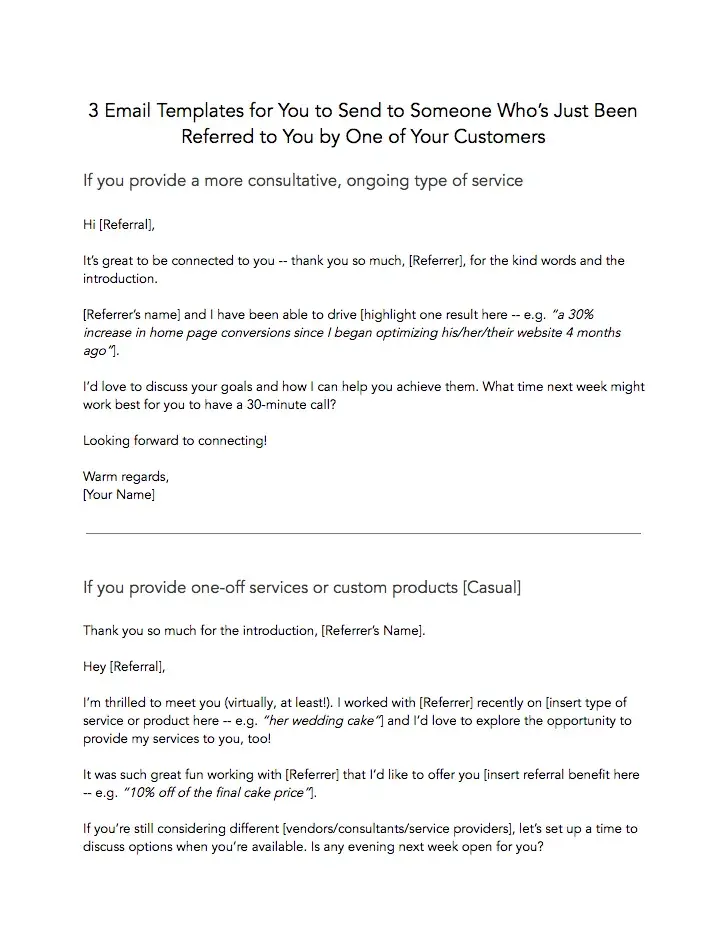
2. Get creative with your referral request channels.
If you can leverage personalization with channels outside of standard email, you can broaden your ability to reach customers where they’re at with a request for a referral.
For software products, in-app messaging (when used sparingly!) can be a great way to ask a customer for a referral when they’re completing something that invokes a positive response.
Chatbots are another great tool to leverage. I’ve seen companies create a referral/testimonial request chatbot flow that pops up on certain pages or when a certain customer behavior is triggered.
When it comes to enabling your customers to bring in referrals on their own, I suggest creating a referral link that’s easy to share across multiple channels. For example, social media is a great place to garner referrals. Companies like Hello Fresh make it easy for existing customers to share referral links on social media with their friends and family.
Finally, text-based referral links can be another creative way to help customers refer their friends and family via the device they’re always on, their phone.
3. Don’t expect immediate results.
Since referrals are built on relationships with your customers, they naturally may take time to come to fruition. Be patient and know that referrals are part of the long game and may not provide immediate results.
To make this strategy work for you, you’ll need to take time to build relationships with your promoter customers. I suggest segmenting this group in your CRM so that your entire organization can track (and communicate) with them effectively.
For example, you can have your marketing team keep an eye on their social media profiles and interact with them when they post. Your account executives can reach out proactively to check in and see how they’re doing. And your support team can even treat them differently (like prioritizing their tickets if possible) when they write in with a request.
Pro tip: Consider tracking your efforts across programs and channels to see how long it takes, on average, from referral request to referral completion. From there, you can iterate across programs and find ways to improve while also tracking which methods result in the most, or the best quality, referrals.
4. Build value before asking.
You can certainly ask for customer referrals immediately after closing the deal — but I wouldn't recommend it (unless it’s a contract renewal).
Wait until your customers are seeing value with your company and have experienced great service from your brand before making this kind of ask. Asking them to give you a referral before they’ve even tried the product isn’t a great move, as it can make them feel uncomfortable since they haven’t actually used your offering yet.
They’ll be more likely to share names of trusted colleagues once they’ve seen value for themselves, and at that point, they’ll want to tell their network about you.
Share relevant content with them and let them know when your company releases new products or features that would benefit them. This is how you continue to build brand loyalty after the sale and turn happy customers into loyal promoters.
5. Ask them, “Do you know anyone else who could benefit from this?”
Some industries have small social circles, so chances are your customers are networking with peers who are facing similar challenges.
By asking your customers if they know anyone facing a similar problem or pain point that they’re experiencing, you’re putting the focus on the solution that your product or service can offer. This helps frame the request to your customers as though they’re helping their colleagues solve a problem, not as though they’re pitching them a product.
For example, if you’re a CSM and you’re in a quarterly business review with a customer, you could ask this question as you review your customer’s success metrics (if the conversation leans positive, of course).
Pro tip: If you have an account team that meets regularly with your customers, have them take note of when their point-of-contact is going to industry conferences or traveling for work. This could be a great opportunity to ask them to keep your offering in mind if they meet anyone at the conference who they think could benefit.
6. Don’t treat referrals like cold calls.
No one likes a cold call. Go into the referral conversation with a warm and friendly tone, and leverage insights from the relationship you have with the referrer. The whole point of a referral is to get a warm introduction, so don’t be afraid to reference things that have come up between you and the referrer.
When appropriate, ask your customer if their referral has any interests or hobbies. When you place your first call, break the ice by saying, “Blair mentioned you know all the best restaurants in Chicago. I’m headed there for work next month and would love some recommendations.” You’ll make the referral relaxed, and you’ll bridge the gap between you and the referrer.
If possible, find common ground and bring it up in a way that feels natural. For example, if the prospect went to a certain alma mater or roots for a certain sports team, you can bring this up in your initial conversation as well.
7. Offer incentives for referrals.
Let’s face it, many of us aren’t going to take the time to refer a friend out of the goodness of our hearts. It’s common to offer an incentive to your customer for taking the time to create a referral.
Consider offering an incentive program that includes gift cards, a discount on next month’s invoice, company swag, or a donation to the charity of their choosing.
You could also create a loyalty program for customers that includes a customer referral program, with higher-value rewards dedicated to referrals.
Whatever the incentive, you can try creating urgency by sending an incentive offer (like a gift card) to a portion of your happiest customers and telling them the first 10 to respond with a referral will receive the prize. (You might be surprised at how fast those referrals suddenly come to your customers’ minds!)
Pro tip: Whatever incentive you offer for referrals, be sure to be up front about the terms and conditions. For example, if you’re offering an incentive just for the referral submission itself, that’s one thing. But if the reward is only given after the referral is considered qualified or after they make a purchase, be sure that you’re clear about that up front with your customers.
8. Get comfortable with asking for referrals in the moment.
It can take some getting used to, but just getting comfortable with this kind of ask can help you leverage those positive yet unexpected moments with customers. If you receive a great comment on a social media post, you can easily reply and ask a customer if they’d be open to giving you a referral.
Or, if a customer calls in and gives you a nice compliment, being comfortable with your ask can allow you to quickly respond with something like, “I’m so glad you had a great experience with us. Would you be open to giving us a referral?”
As a customer success manager, when I prepared my QBR decks, I would include a slide at the end of them that asked my customers for a referral if I knew the customer would be happy with the outcome of the meeting.
While you, of course, want to create a referral program that’s well-thought-out and structured, you also want to be prepared to ask for a referral in the moment if the opportunity arises.
Pro tip: This is where having a standardized referral form comes in handy. By responding to social media comments with a referral link, or having a QR code displayed in your brick-and-mortar business, you can easily help customers give you a referral when the opportunity arises.
9. Stay connected with your customers.
Whether a customer has said no to a referral or you haven’t asked yet, keep building the relationship with them. Staying in touch makes your eventual request feel natural, not sudden or pushy.
Here are a few ways you can stay in touch in an authentic and human way that will keep the door open for future referrals:
- Set up Google Alerts for their name or business so you can drop them a quick “congratulations” email if they receive an award, another round of funding, open a new office, etc.
- To take it a step further, congratulate them on social media and share their success with your network.
- Connect with them on LinkedIn, and follow their updates so you can like and comment on statuses, job changes, and blog posts.
- When their company is hiring or looking for help from their network, share their posts with your own network.
- Follow them on X so you can read their updates and chime in on conversations that are relevant to you.
- Subscribe to their personal or company blog — if they have one — and send them an email when one of the blogs is particularly resonant.
- If they live in the same area as you, ask them out for a cup of coffee. If you don’t live in the same area, offer to host them if they’re ever in your city.
10. Share and celebrate your customers’ work.
Business owners know that there’s power in banding together and sharing other businesses’ work, offerings, events, and promotions.
By sharing your customers’ work with your network, you build goodwill and strengthen the relationship between your companies. By doing this, you also inadvertently refer them by highlighting them in your network.
If you do this on a regular basis, it won’t be unreasonable to ask for referrals when the time comes because you’ll already have been singing their praises, too.
Pro tip: When working directly with customers, actively listen to what projects they’re working on that they’re excited (or even nervous) about. Once you see those projects go live, celebrate them either in your network or in your next meeting with them.
As a CSM, I would often directly credit my point-of-contact for the success metrics I was presenting on during quarterly business reviews with their C-suite team. This was a nice way to show the customer some well-deserved recognition while also showing the C-suite that we were paying attention to their company’s initiatives.
11. Focus on your strongest relationships.
While you can certainly ask for referrals from your entire customer base, you’ll want to focus your efforts on your happiest and most successful customers. These are the customers that are most likely to generate qualified referrals for you since they’re the ones who have seen success with your offering.
They may have already indicated their interest in serving as a referral source by filling out a positive customer review, giving you high marks in a feedback survey, or by indicating that they’re happy with your work and like working with you.
If you’re offering incentives for referrals, you’ll want to consider your budget restraints and make sure that you’re prioritizing this subset of customers first for referral generation. It would be a shame to run a promotion to all customers and quickly run out of budget, only to find it wasn’t your top-tier customers who were the ones that participated!
Pro tip: If your company leverages a customer health score, you can prioritize reaching out to customers whose health score reflects a combination of high product adoption, positive ROI, and/or positive sentiment.
12. Add referral options to your website.
Make it easy for your customers to refer you, even without you asking. By adding an online form, box, chatbot, or page with a referral link to your website, you encourage more referrals from customers and reduce manual outreach effort for your team.
Whatever functionality you decide to add, make the CTA clear and be sure to list any incentives that you’re offering for qualified referrals. Try to make the process as self-serve as possible so that customers can generate referrals for you on their own.
Pro tip: Test this process to make sure there’s no unnecessary friction for the customer. I’ve seen some referral programs that are so clunky and complicated that I’ve personally quit on them mid-referral. When in doubt, KISS (keep it super simple).
13. Consider a quid-pro-quo mindset.
Offering to refer others in exchange for a referral from your company is a great way to team up with other businesses and combine referral efforts.
You could reach out to your own customers (where it makes sense) and ask if they’d like to participate in a referral exchange. I’ve seen this work well at the C-level, where my marketing team worked with CEOs or CMOs from both my company and my customer’s company to exchange very custom, personalized referrals.
You could also consider finding a referral networking group that offers mutually beneficial opportunities with other businesses. This is a great place to get a referral without the awkwardness that can come in other settings, and you’ll also stand out in your team for proactively seeking referral opportunities outside of your immediate network.
Pro tip: I don’t suggest using this as your only referral strategy, but it can be a complementary strategy to source referrals in addition to some of the other methods that we’ve discussed so far. It can be especially beneficial for small businesses or a business that’s just starting out, as well as those in the services industry.
Customer Referral Letter Templates
Once a new customer is onboarded, let enough time pass to produce some results. You want the customer to decide whether they’re pleased with your work or not. This could take a week, or it could be a few months, but when you’re satisfied you’ve made an impression, follow up by asking directly for referrals using these templates inspired by our friend Rick Roberge:
Customer Success Manager: “You told me you’re happy with my work thus far, and I’m glad to hear that. Have you shared these sentiments on a review board or with a friend or colleague?”
Customer: “No, I hadn’t thought about it.”
CSM: “Is it because you’re not pleased with the outcomes?”
Customer: “Not at all, we’re pretty happy with the quality of the product and service we’re receiving.”
CSM: “That’s great! Perhaps your clients, vendors, or competitors might need this same level of quality from a software service like ours. What do you think?”
Customer: I don’t want you working with my competitors, but I can think of a few vendors who might want to work with you.”
CSM: “Your vendors then — do you have a favorite? Do they sell to other people you know?”
Customer: “Yeah, we have a good relationship.”
CSM: “And are any of your favorite vendors trying to grow their businesses?”
Customer: “Yes, a few in particular.”
CSM: “There sounds like an opportunity here. If you called or sent your favorite vendor an email and said ‘I’ve been working with [Name] for six months, and we’re doing some pretty interesting stuff. I know you’re growing your business, so I thought I’d put you two together,’ would they be receptive?”
If your customer agrees their vendors would be open to the suggestion, send out the email template in the section below.
If your customer is on the fence, work to reframe the situation to assure them they’d be helping the referred party, not setting a money-hungry sales rep on their trail. Emphasize to your customer that your purpose is to grow businesses — or whatever your company’s mission may be — and not to be a hard-pitching nuisance.
Template 1: How to Ask for a Referral From a Loyal Customer
When requesting a referral, you want to keep the focus on your customer and their happiness. You don’t want to appear like an opportunistic sales rep who’s done with them and ready to move on to their friends — you want to seem like a helpful CSM who’s invested in building your relationship.
Instead, only ask for a referral after first ensuring they’re happy with your product or service and can think of no way in which their experience could be improved. Then, gently ask if they have a friend or industry colleague you might be able to achieve similar results with.
Here’s an example:
Hello [Customer name],
I’m so glad to hear you’re happy with the results of working with [Your company name] so far. I knew we could help, and I’m pleased you’re seeing results so quickly.
Since things are going so well, I found myself wondering if you have any colleagues at similar companies who would benefit from our [product/service]. I would love to help them achieve similar growth.
Regards,
[Your name]
This is friendly, focuses on your customer’s success, and is hopeful you can help one of their friends at another company achieve the same results. Who could say no to that?
Template 2: How to Ask for a Referral From a New Customer
A new customer may be a more difficult ask than an existing one with a wealth of positive experience with you. However, it may still be a good idea to ask a new customer for a referral on the back of a successful onboarding experience.
It’s at this point — if everything’s gone well — that their emotions are high on having solved a big problem using your offerings, and they’re still in the honeymoon phase. Only ask after a moment of delight during the beginning of a relationship, and don’t wait for buyer’s remorse to set in or those emotions to level off.
Be sure to ask for feedback throughout the process, and after a particularly glowing email, respond with your ask. For example:
Hello [Customer name],
That’s amazing that you’ve had such a great experience with our team already. They continue to surprise even me, and I work with them daily.
I trust they’ll take care of you through the rest of the process, and you can always reach back out to me with any questions. In the meantime, since you’re in good hands, do you know anyone else who also needs help with [pain/problem that led them to you]?
Let me know,
[Your name]
Template 3: How to Ask for a Referral From a Partner, Vendor, or Affiliate
You likely have service providers, affiliates, or — best of all — partnerships in your industry who offer solutions complementary to yours. If you have a good relationship with an individual at one of these companies, you might have an opportunity to tap into their sphere of influence.
The goal is to provide value to their clients/contacts. Here’s how you can approach the topic:
Hello [Point of contact’s name],
I’ve noticed that our customers who work with [their company name] have far fewer issues with [problem that they solve] on average. I think that [your company name] and [their company name] makes for a powerful combination.
Do you currently know anyone who would benefit from [your solution]? I’d be happy to help.
Best,
[Your name]
You may also consider adding an incentive to your email such as providing them with a referral in turn or promoting their product/service on your social media channels.
Template 4: How to Ask for a Referral From a Customer on Social Media
If you follow our advice about staying connected with your customers, you may find yourself interacting with potential referrals within their network. Sites like LinkedIn and X are great places to meet new people and engage informally about topics that align with what your business sells. And, when the time is right, this can be a relevant and natural way to ask your customers for a referral.
The key here is to show your customer that the referral you’re looking to connect with has a reason to hear from you. In this example, both you and the potential referral commented on the customer’s LinkedIn post.
Hello [Point of contact’s name],
Thanks for sharing [reference the information in a post you enjoyed] on your LinkedIn post. I was able to converse with quite a few of your constituents in the comments, and as I got to know [name of person you engaged with in the comments] more, I think her business could benefit from [solution you provide]. Since you and I have had a great working relationship thus far, would you mind initiating a formal connection between [prospective referral name] and me? I’d greatly appreciate it!
Looking forward to hearing from you,
[Your name]
What makes this example so great is the fact that your customer won’t need to put much thought into the connection. You’ve already told them how you know their colleague and you were transparent in the reason you want to connect with them.
Template 5: How to Ask for a Referral From a Competitor
In some industries, mainly those with large markets, your competitors may not be targeting the exact same clients as you. For example, if you’re a real estate agent who specializes in working with first-time home buyers, you might consider referring clients who don’t fit that bill (like relocation buyers or buyers with past foreclosures) to a competitor.
With that in mind, you can start to gauge whether your competitors with overlapping but different specialties would do the same for you, especially if they have more overflow than they can handle. You can broach that topic like so:
Hello [Point of contact’s name],
I’ve noticed that you specialize in [insert specialty or niche]. I’ve had quite a few clients I’ve turned down recently who could’ve used services in that area. I’d be happy to send them your way in the future because my ideal client is more along the lines of [description]. If you have any overflow in that area, my company [write in your value proposition] and could provide those clients value.
Looking forward to hearing from you,
[Your name]
Template 6: What to Say When They Agree to Make the Referral
If you have a favorable response to any of the emails above, reply with, “Great, I have an easy email template I’ll share with you. All you have to do is press send!” Provide them with the email template below, and you’ll make it simple for customers to refer you:
[Referral],
I don’t know if I’ve mentioned it before, but I’ve been working with [CSM name] for a few months. The other day, I was talking with her about some of the things she and I have done, and I realized I should put you two together. So...
[Referral], meet [CSM, with a LinkedIn profile URL].
[CSM], meet [Referral, with a LinkedIn profile URL].
Can I leave the rest to you guys?
Talk to you both later.
Regards,
[Name]
The customer isn’t asked to explain what the CSM does. It’s not their job to sell the referral — it’s yours. From there, you can take it away, or connect them with a salesperson at your company.
Phrasing it in this manner builds on the mutual respect between customer and referral by implying the referral can give the CSM the benefit of the doubt. Also, because both the customer and the CSM are on the email, it would be appropriate for either to follow up.
After sending this referral template, check in a week or two later with your customer and ask — gently — if they sent it out. If they haven’t, reply that it’s no problem, and don’t ask again.
If, on the other hand, they have sent it, and you hadn’t been included on a reply, ask if the customer got a “No, thank you” from the referral. If that’s the case, cross that referral off your list. If there was no reply at all, ask if they would like you to reach out directly.
Template 7: How to Thank a Referral Source
The key step to maintaining positive customer relationships after you connect with their referrals is to say thank you. Your customer connected you with a valuable member of their professional network, vouched for your professionalism and the value of your product or service, and conducted outreach on your behalf.
To show your appreciation, send an email or letter promptly after a specific point in the referral process — usually after the referral has made their first purchase. Send a short, sincere, and personalized thank you letter to show your referral source how much you appreciate their contribution to your success.
If you can, offer them a reward for referring a new customer to you. Even if it’s something small, the gesture can go a long way.
Here’s a template you can use as the basis of your thank you letter:
Dear [Referral Source],
Thank you for referring [Referral Name] to me for [Your Product/Service Offering]. [Referral Company] is a big organization, and I sincerely appreciate your vote of confidence in my abilities by referring them to [Your Company]. We’re going to work together on [Services/Project/Initiative] over the next several months, and hopefully [Product/Service Offering] will be as helpful for them as it has been for you.
As a token of my appreciation, here’s a promo code for 10% off your next purchase from us.
Thank you again for connecting me with [Referral Name], and I look forward to talking again soon.
Kind regards,
[Your name]
Referral Email Examples
Now that you’ve seen some referral templates, let’s look at some real-world examples of referral emails.
1. Morning Brew
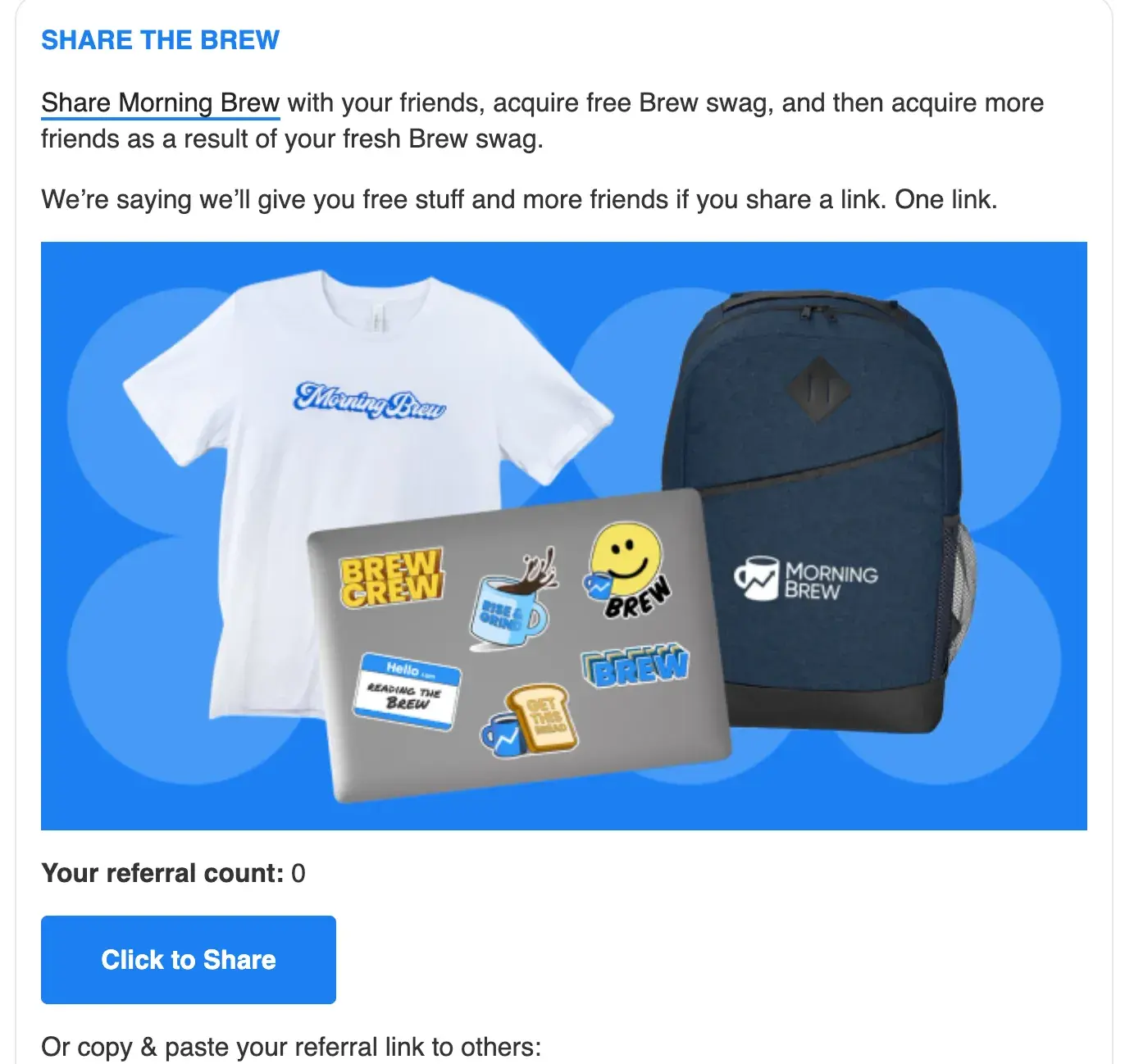
Morning Brew takes a cheeky and casual approach to their referral program, embedding it into their daily newsletter and using humor in how they entice you to participate.
Why This Works
The language they use is true to their brand voice and resonates with the demographic of their reader. They draw the reader in by including an image showing what they can earn for participating. The referral “counter” is also a nice touch, encouraging readers to get busy referring their friends.
2. Confetti

This is an example of a B2B referral email I personally received, as I use Confetti for our ERG events at my company. In this example, Confetti leads with the incentive they’re offering for a referral, as the title of the email was “$200 says your friends will love Confetti.”
Why This Works
$200 is a pretty generous incentive, so leading with that works well here. They also leverage the fact that I would want to share the “confetti magic” with my friends or colleagues, leaning into the value proposition of their offering. Clearly calling out the T&C below is also a nice touch, so there’s no confusion for the referrer.
What I’d change: While this email addresses me by name, it could have included more personalization, even as an automated email. I’ve booked many events with Confetti, and they could have easily used personalization to pull in the title of a recent event I booked with them before asking for a referral.
3. QVC
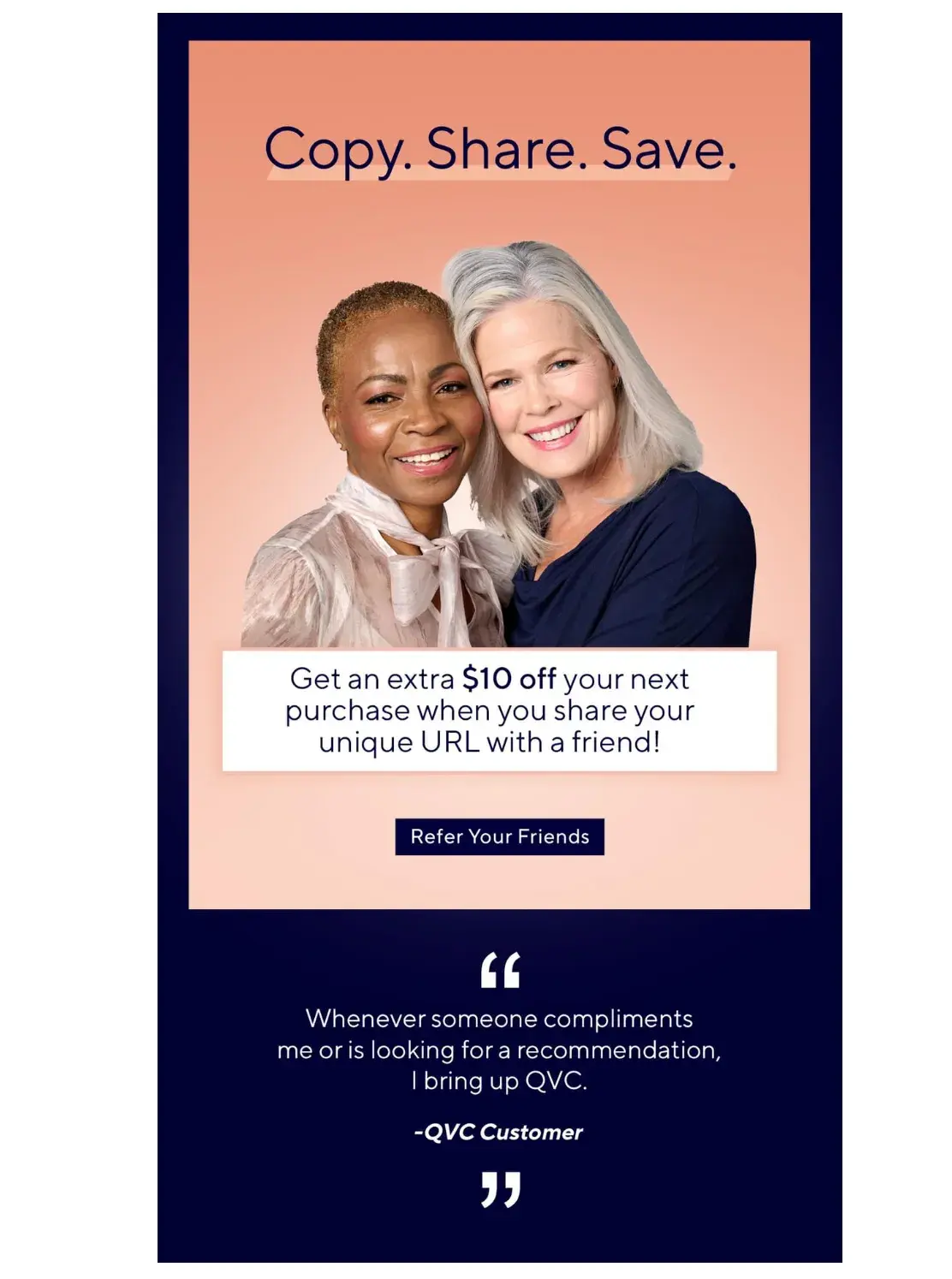
If you run an ecommerce brand, using referral links are a great way to get customers to get the word out. QVC does this by emailing customers with an offer to encourage them to refer their friends.
Why This Works
This email incentivizes existing customers to refer new ones by offering them a reward credit. They also make it easy to do by including the customer’s unique referral URL in the email, which reduces friction and makes it easy to copy it and share it.
Finally, I like the added touch of including a customer testimonial at the bottom of this image, as it gets the customer thinking about when they personally may have been complimented on something they purchased from QVC.
4. Gong.io - Influencer Club

Gong’s loyalty program offers its members the chance to partake in a variety of advocacy initiatives, including a referral program. Since my company uses Gong, I was invited to join their “Influencer club” and participate in advocacy initiatives of my choosing.
Above is the email Gong sends via an automated outreach, but from a real person’s email address, that invites you to join the program. While it doesn’t directly ask for a referral, it invites you to participate in a broader program that rewards you for things like referrals.
Why This Works
This email leverages personalization (my name) and makes the request feel human by focusing on the customer and contributing to their success in the opening line. It also feels low pressure and doesn’t come off as spammy.
5. Account Team Customer Outreach
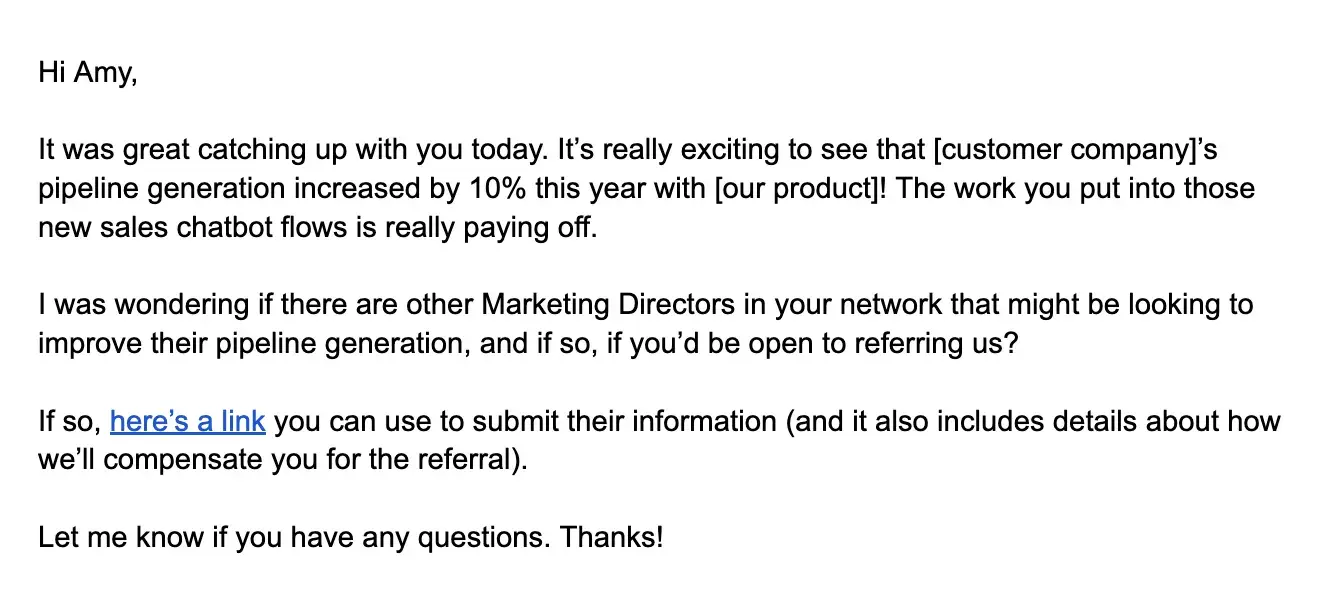
As a CSM, here’s an example email that I might send to one of my customers after connecting with them.
Why This Works
This email recognizes the value the customer is actually seeing from our product, celebrates the measurable win, and acknowledges the customer’s effort. By referencing the customer’s title, I help narrow down the list of potential referrals, making it easier for the customer to think through who they could connect with me.
Finally, I include a link that makes it easy for the customer to submit the referral information on their own time, as they may want to go talk to the people they’re considering referring me to before they submit their information to me. I also mention that we’ll compensate them for the referral but I don’t lead with it. Instead, I lean on our relationship and the work we’ve done together.
Start sourcing referral opportunities.
Referral marketing isn’t going anywhere, and acquiring customers through referrals continues to be a cost-effective acquisition model that offers long-term revenue benefits. This means that creating or refining your referral program is worth the investment, and the best time to get started is now.
I suggest leveraging customer sentiment, direct feedback, and customer behavior data to first identify which customers would make great advocates. From there, I recommend engaging with those advocates and strengthening your company’s relationship with them so that you can eventually ask them for a referral.
Once you’re ready to make the ask, use the email templates and guidance in this article to craft a compelling message that resonates with your customers.
By following these guidelines, you can build a referral strategy that increases customer lifetime value, lowers customer acquisition costs and scales with your business.
Net Promoter, Net Promoter System, Net Promoter Score, NPS and the NPS-related emoticons are registered trademarks of Bain & Company, Inc., Fred Reichheld and Satmetrix Systems, Inc.
Editor's note: This post was originally published in April 2018 and has been updated for comprehensiveness.
Customer Acquisition
.png?width=112&height=112&name=Image%20Hackathon%20%E2%80%93%20Vertical%20(11).png)
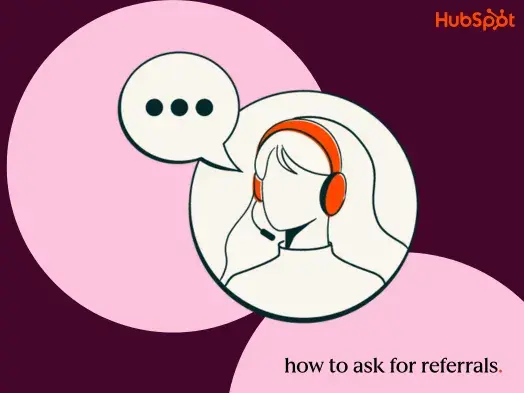
.png)

![7 Customer Acquisition Challenges You Might Face This Year [New Data]](https://53.fs1.hubspotusercontent-na1.net/hubfs/53/customer%20acquisition%20%20(1).webp)




